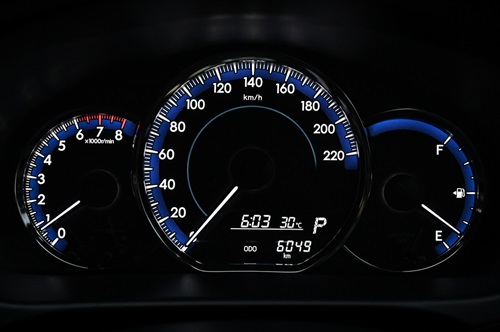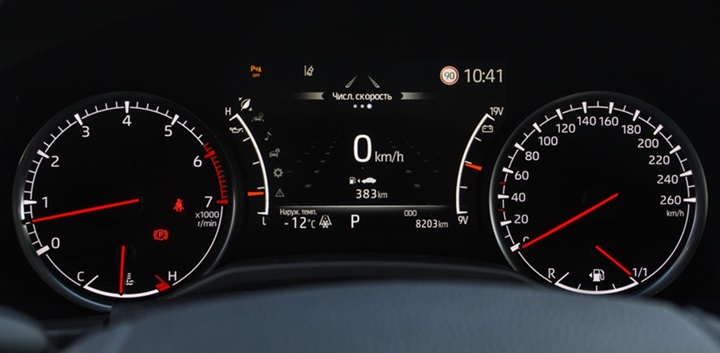Ever found yourself cruising down the road, only to notice that your trusty speedometer isn’t quite doing its job? It’s a common issue that can leave you feeling a bit perplexed and concerned about your vehicle’s health. But fear not! In this article, we’re going to dive into the nitty-gritty of why your speedometer might be acting up, explore the potential causes behind this problem, and, most importantly, share some handy fixes to get you back on track. So, buckle up and join us on this journey to unravel the mysteries of the malfunctioning speedometer. Your smooth and safe rides are just a few paragraphs away!
Outline
Toggle- What is a Speedometer?
- How Does a Speedometer Work?
- What are the Types of Speedometers?
- Reasons Behind Speedometers Not Working
- 1. Speed Sensor Issues
- 2. Faulty Wiring or Connectors
- 3. Instrument Cluster Problems
- 4. Vehicle Speed Sensor (VSS) Failure
- 5. Sensor Calibration Issues
- 6. Faulty Speedometer Head or Display
- 7. Vehicle Computer Problems
- 8. Speedometer Gear or Gearbox Problems
- 9. Excessive Mileage or Wear and Tear
- 10. Environmental Factors
- How to Diagnose and Fix Your Speedometer?
- How Much Will it Cost to Fix My Speedometer?
- Speedometer Not Working – FAQ
- Conclusion
What is a Speedometer?

How Does a Speedometer Work?
The operation of a speedometer is based on a combination of mechanical and electrical components. Most modern vehicles use an electronic sensor mounted on the vehicle’s transmission, which generates electrical pulses in proportion to the rotation speed of the vehicle’s wheels. These pulses are then transmitted to the speedometer, where they are converted into a speed reading that is displayed to the driver. The faster the vehicle moves, the more pulses are generated, causing the speedometer to indicate a higher speed. This mechanism ensures that the speedometer provides an accurate reading of the vehicle’s speed, allowing drivers to maintain safe and lawful speeds while on the road.
What are the Types of Speedometers?
Speedometers come in two primary types: mechanical speedometers and electronic speedometers. Let’s take a closer look at each:
1. Mechanical Speedometers

2. Electronic Speedometers

While both types of speedometers serve the same fundamental purpose of indicating a vehicle’s speed, electronic speedometers have largely replaced mechanical ones due to their greater precision and versatility.
Reasons Behind Speedometers Not Working
Speedometers can stop working for various reasons, and diagnosing the exact cause is essential for a safe and smooth driving experience. Here are some common reasons why speedometers may malfunction:
1. Speed Sensor Issues
Speed sensors, whether mechanical (cable-driven) or electronic, can fail or become damaged. Mechanical speedometers may have a broken cable or worn-out components, while electronic speed sensors can malfunction or accumulate debris hindering their operation.
2. Faulty Wiring or Connectors
Electrical problems within the wiring or connectors that link the speed sensor to the speedometer can disrupt the signal transmission. Corroded or damaged wires, loose connections, or blown fuses can all lead to speedometer issues.
3. Instrument Cluster Problems
In modern vehicles with electronic instrument clusters, a malfunction in the cluster itself can result in speedometer inaccuracies. This may be due to a failing stepper motor, display circuitry, or a software glitch.
4. Vehicle Speed Sensor (VSS) Failure
The Vehicle Speed Sensor, which calculates speed for various vehicle systems, can fail. If it’s not functioning correctly, it can affect the speedometer’s accuracy and lead to irregular readings.
5. Sensor Calibration Issues
In some cases, the speedometer may need calibration or reprogramming, especially if you’ve made modifications to your vehicle’s tire size, gear ratio, or transmission.
6. Faulty Speedometer Head or Display
Physical damage to the speedometer head or its display can cause erratic readings or a complete failure. This is more common in older mechanical speedometers.
7. Vehicle Computer Problems
Modern vehicles rely on the Engine Control Module (ECM) or other onboard computers to calculate and transmit speed data. If these computers experience issues or glitches, it can affect the speedometer’s performance.
8. Speedometer Gear or Gearbox Problems
In some older vehicles, there’s a mechanical gearbox that connects the speedometer cable to the transmission. If this gearbox is damaged or worn, it can result in speedometer inaccuracies.
9. Excessive Mileage or Wear and Tear
Over time, the components of a speedometer can wear out due to regular use, leading to a gradual decline in accuracy or functionality.
10. Environmental Factors
Extreme temperatures, moisture, or exposure to the elements can damage the speedometer and its components over time.
To address speedometer issues, it’s crucial to identify the root cause through diagnostics. This may involve inspecting the speed sensor, checking wiring and connectors, and using diagnostic tools to assess the vehicle’s systems. Once the problem is identified, appropriate repairs or replacements can be made to restore the speedometer’s functionality.
How to Diagnose and Fix Your Speedometer?
Diagnosing and fixing speedometer issues can be a straightforward process if you follow a systematic approach. Here are the steps to diagnose and fix your speedometer:
1. Diagnosis
- Check for Obvious Signs: Start by observing your speedometer’s behavior. Does the needle remain at zero, fluctuate erratically, or show consistent inaccuracies? Identifying the specific issue can provide initial clues.
- Test Your Odometer: Ensure that your odometer is working correctly, as it often relies on the same sensors and wiring as the speedometer. If the odometer is also malfunctioning, it may point to a sensor or wiring issue.
- Inspect the Speedometer Fuse: Locate the speedometer fuse in your vehicle’s fuse box and check if it’s blown. A blown fuse can cause the speedometer to stop working. Replace it if necessary.
- Check Wiring and Connectors: Inspect the wiring and connectors between the speed sensor and the speedometer for any visible damage, loose connections, or corrosion. Repair or replace any damaged components.
- Scan for Error Codes: Use an OBD-II scanner to check for any stored error codes in the vehicle’s computer system. Speed sensor-related codes, such as P0500 or P0501, can provide valuable diagnostic information.
- Test the Speed Sensor: Depending on your vehicle’s type of speed sensor (mechanical or electronic), perform a sensor test. For electronic sensors, use a multimeter to check for voltage or resistance within the specified range.
2. Fixes
- Replace Faulty Speed Sensor: If your speed sensor is determined to be faulty, replace it with a new one. Be sure to choose the correct sensor for your vehicle’s make and model.
- Calibrate the Speedometer: In cases where you’ve made modifications to your vehicle’s tires, gears, or transmission, consider calibrating the speedometer to match the new settings. This may require a visit to a mechanic or a dealership with the necessary tools.
- Repair Wiring and Connectors: Address any wiring or connector issues you identified during the diagnosis. Repair damaged wires, secure loose connections, and clean corroded terminals. Ensure the wires have the correct resistance.
- Replace the Speedometer Head: If your speedometer head is physically damaged or defective, it may need replacement. This is more common in older mechanical speedometers.
- Consult a Mechanic or Technician: If you’re unable to identify or fix the issue yourself, consider consulting a professional mechanic or automotive technician. They have the expertise and diagnostic tools to pinpoint and repair complex speedometer problems.
- Update Vehicle Software: For vehicles with electronic instrument clusters, updating the vehicle’s software or addressing any software glitches may resolve speedometer issues. Consult your vehicle manufacturer or a dealership for software updates.
Remember to prioritize safety when diagnosing and fixing speedometer problems. Ensure your speedometer is functioning correctly before driving, as accurate speed information is crucial for safe and legal driving.
How Much Will it Cost to Fix My Speedometer?
The cost of fixing a speedometer can vary widely depending on several factors, including the underlying issue, the make and model of your vehicle, and labor costs in your area. For minor issues like a blown fuse or simple wiring repairs, the cost might be relatively low, ranging from $50 to $200. Replacing a faulty speed sensor could cost between $100 and $300, including parts and labor. However, if the problem involves more complex diagnostics, such as issues with the instrument cluster or vehicle computer, the cost can escalate significantly, potentially exceeding $500 to $1,000 or more. It’s essential to consult with a trusted mechanic or automotive technician for a precise estimate based on your specific vehicle and the nature of the speedometer problem.
Also Check:
Why Does My Car Losing Power When Accelerating?
Reasons Your Car Won’t Go in Reverse & How to Fix?
Speedometer Not Working – FAQ
Ans: While it’s not illegal to drive without a working speedometer, it’s highly discouraged and potentially unsafe. A functioning speedometer is crucial for maintaining safe speeds, adhering to traffic laws, and avoiding fines. If your speedometer is malfunctioning, it’s advisable to get it repaired promptly to ensure both your safety and compliance with road regulations.
Ans: Using your phone as a replacement speedometer is possible, thanks to various GPS-based speedometer apps available. These apps use GPS signals to determine your speed accurately. However, keep in mind that they may not be as reliable as your vehicle’s built-in speedometer, especially in areas with poor GPS reception. Also, using your phone while driving can be distracting and is often discouraged or even illegal in some places. So, while it can serve as a temporary solution, it’s best to get your vehicle’s speedometer repaired for safety and legal compliance.
Ans: If your odometer is working while your speedometer is not, it indicates a potential issue with the speed sensor or the instrument cluster in your vehicle. The odometer typically relies on the same sensor or signal as the speedometer, but it may be more resilient to certain types of malfunctions. To diagnose and address this problem, it’s essential to check the speed sensor, wiring, and instrument cluster for any faults or damage and, if needed, seek professional assistance for repairs.
Conclusion
In conclusion, your vehicle’s speedometer not working can be a bit of a speed bump on your driving journey, but it’s a hurdle that can usually be overcome. We’ve explored the various causes behind this issue, from sensor malfunctions to wiring woes, and even the occasional software glitch. The good news is that many of these problems can be resolved with some DIY troubleshooting or a visit to your friendly neighborhood mechanic. So, whether you’re cruising in a classic car with a mechanical speedometer or driving a modern marvel with an electronic display, remember that understanding and addressing speedometer issues is essential for safe and worry-free travels. With the right knowledge and a bit of patience, you’ll be back on the road, confidently tracking your speed in no time. Safe travels!

